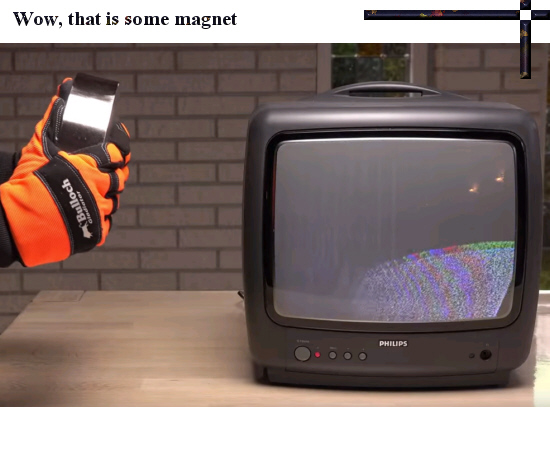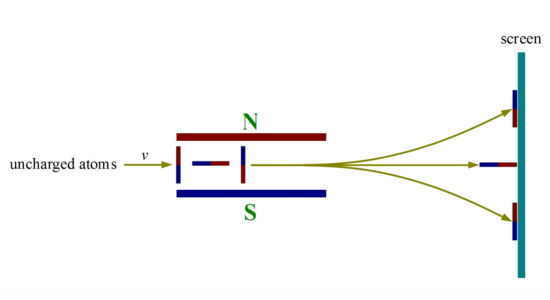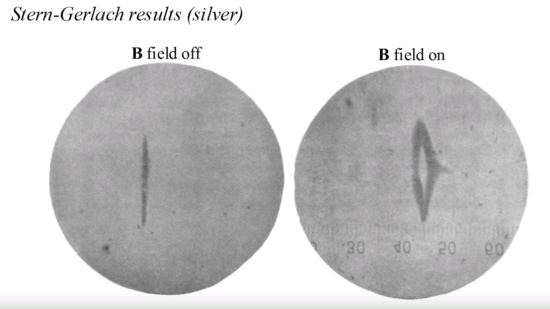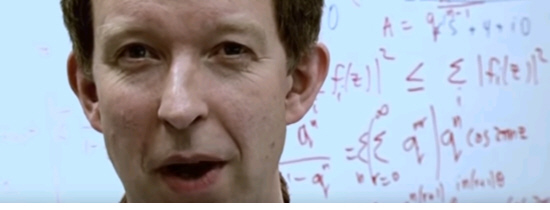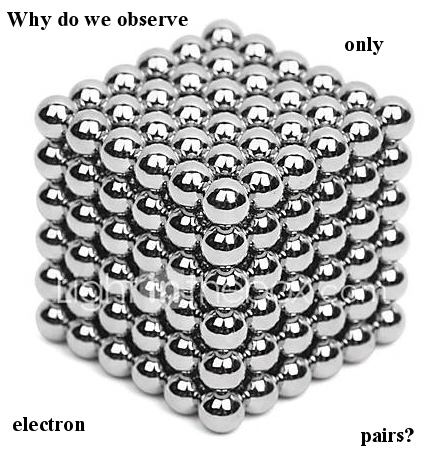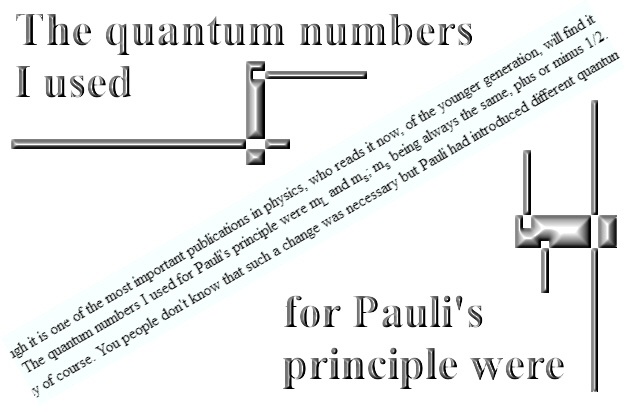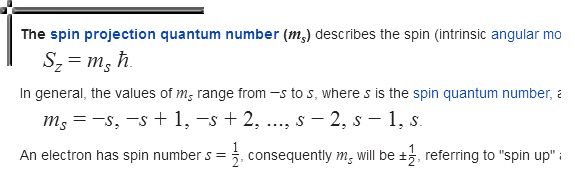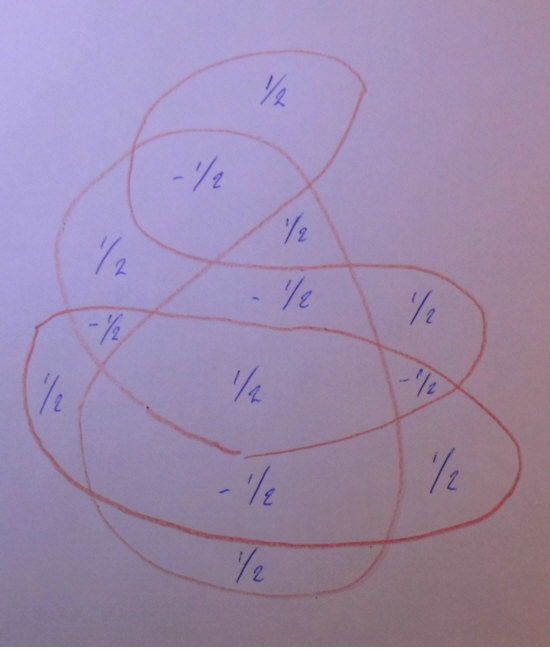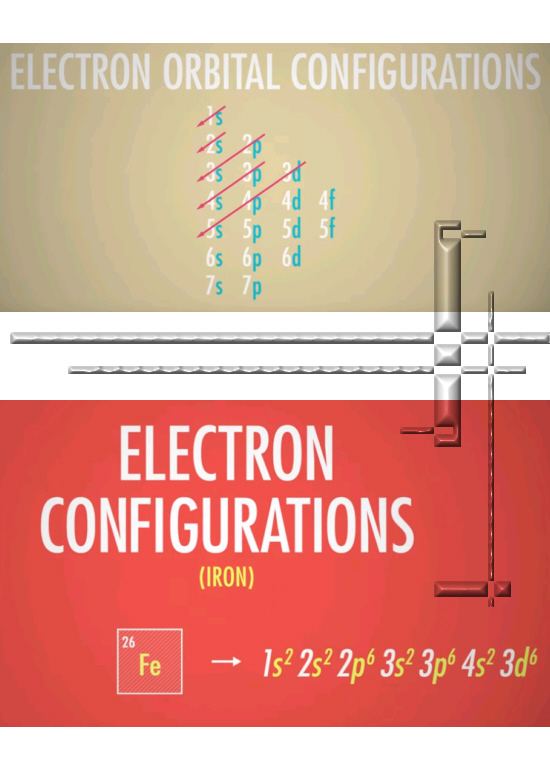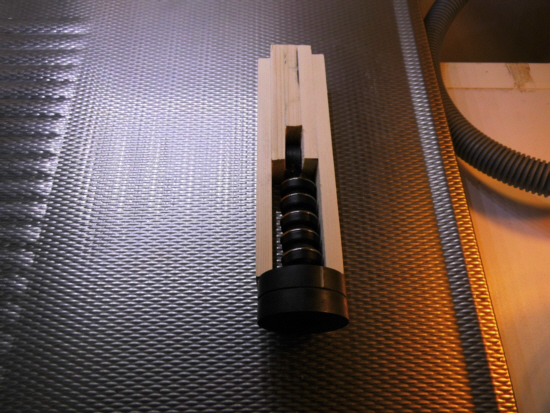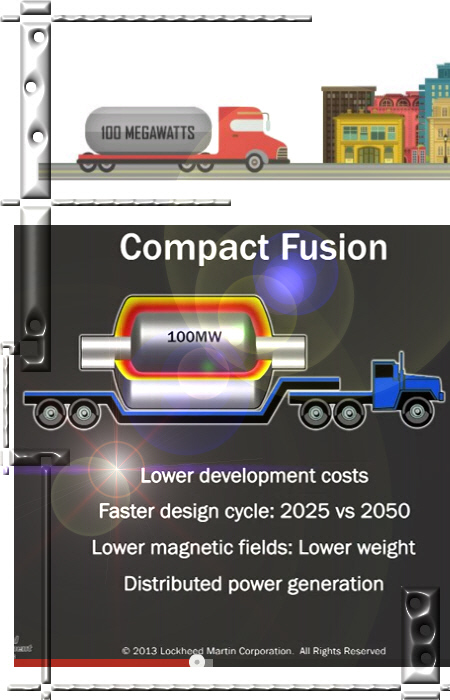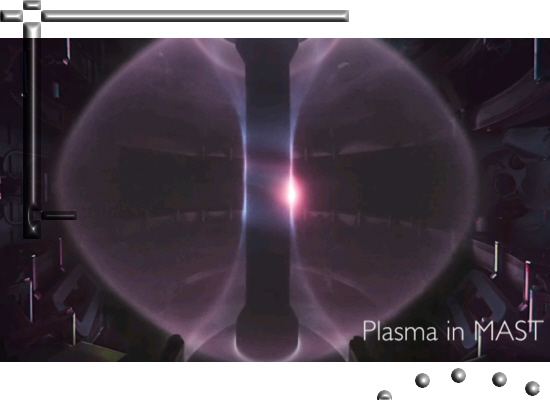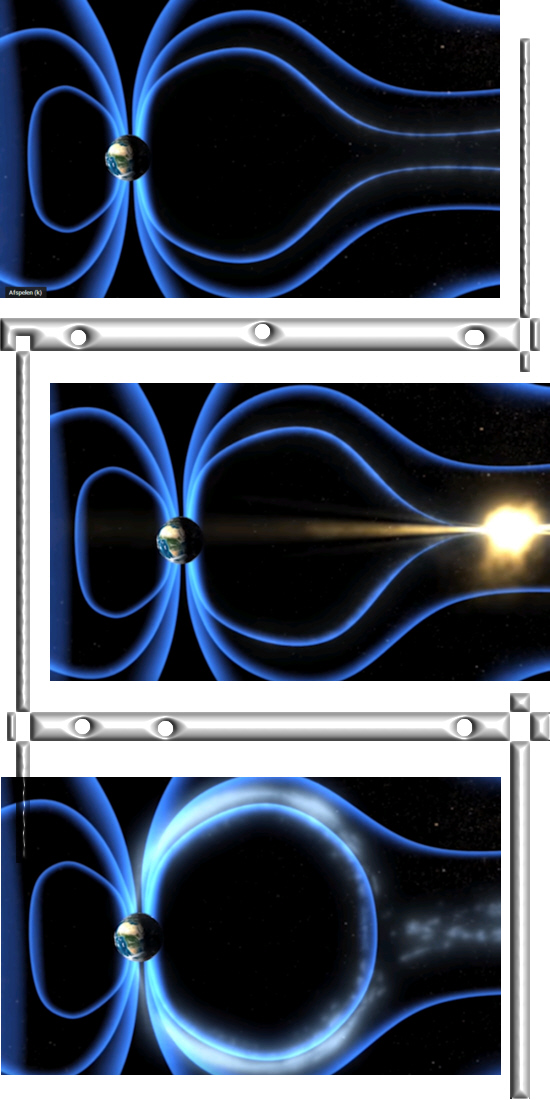| Page 4 of the magnetic pages covering the stuff found in the year 2019. | |||
|
|
|||
| Introduction: In
this html page on magnetism we will focus on a weird detail of the so
called Stern-Gerlach experiment from the year 1922 where they managed to
separate a stream of silver ions into two parts. And the culprit was one loose unpaired electron that did split this stream of silver ions. I was 50 years of age when I
read these weird results for the first time and I did not understand
them: Within two days I had the answer: Electrons are magnetic monopoles because only monopoles can be repelled by the stronger side of a magnetic field. I was very surprised by my own result because I too was indoctrinated by 'Magnetic monopoles do no exist' kind of thinking. Anyway, two years back that was the starting point of the 'electrons are magnetic monopoles'. Have fun reading it and
hopefully you will learn something from it.
|
|||
|
|
|||
|
11 Jan 2019:
Reason 68 Elevator pitch for electron magnetic monopolism.
An elevator pitch is a very short thing, for as long as the elevator is going up you are allowed to explain as why rich people should invest in your internet startup. The phrase 'elevator pitch' dates back to just before the turn of the millennium when the internet was released on humanity and stock markets went crazy far and deep. May be a sudden endless supply of free porn was not a good thing... ;) Ok, but I am starting to ride beside the rails because this page is not a discussion or a study of free internet porn on the behavior of entire societies. No no, we only check year in year out if electrons can be magnetic dipoles yes or no. Official physics theory says even electrons are magnetic dipoles, see for example the Gauss law on magnetism. But a cute blanket of math from Herr Gauss is of course not the same as experimental results that can be repeated. As far as I know there is no physics experiment that 'proofs' or validates that electrons are magnetic dipoles. After all, if electrons are magnetic dipoles they are magnetically neutral and as such are not influenced very much by magnetic fields. Just like non-ion molecules or atoms are not very much moved by electrical fields. __________ My 20 second long elevator pitch goes as next: If a chemical element has only
electron pairs, it is always dia magnetic. End of the elevator pitch, at present time this is the shortest way I could think of explaining there is something wrong with the current understanding of electrons always be magnetic dipoles.
|
|||
|
14 Jan 2019:
Reason 69: At least he shows the Lorenz force.
From the Youtube channel Brainiac75 there is a nice video about the dislocation (repelling) of a candle flame by those strong permanent magnets. It is actually a very nice video although on details I would formulate it a bit different. For example the burning flame is indeed a plasma but I don't think it is 100% ionized in the sense the atomic nuclei still have electrons bound. So I would not name it a plasma. But anyway, the video guy also has giant magnets and about 4 minutes into the video he even tries them out on an old television set. It is a pity he is doing it from the side, likely he wants to maximize the Lorentz force that is perpendicular to both the magnetic field and the direction of the electrons. If he would have put that giant magnet before the screen he should have a very different picture: Also in the center there should still land electrons on the television screen.
The next picture if from 4:26
minutes into the video. Title of the video: Monster magnet meets flames... The brainiac 75 guy holds the giant magnet at the side of the electron stream inside the old television. That maximizes the Lorenz force. (The Lorentz force is in the direction of the outer product of the electron stream and the applied magnetic field, so the Lorenz force is always perpendicular to the electron stream and the applied magnetic field.). Without doubt the brainac guy also has hold hid giant permanent magnet in from of the television screen, but since what you see is rather hard to explain this away with the Lorenz force and as such the human brain simply ignores it... Anyway that is what happens in most people I think: you just ignore the stuff you don't understand until you have to change course. So I tried to make a bit more photo's myself because I still have those magnetron magnets and they are ring shaped. And indeed with the camera mounted on an old tripod I was able to make the next photograph: Click on the picture for a larger version. I changed nothing in the photo. As you see on inspection: the middle spot is very bright indicating a lot of electrons are landing there. Of course it is hard to draw definitive conclusions from just one photo, after all you can still have Lorenz force fantasies by this but the general view that electrons are just always deflected by magnetic fields is simply not true. In that case we would not observe the dark ring where no electrons land. In my view, as stated clearly for the new year, is that electrons carry magnetic charge and as such are magnetic monopoles and not magnetic dipoles. That is what I had to say for this simple update in the magnetic pages. Till updates.
|
|||
| 16
Feb 2019: Reason 70: Comparison with ions in an electric field.
This page is a bit going to the backburner because, like said before, after over 66 of these 'reasons' it is not longer a matter of cognitive brain functioning but only emotional stuff. And if people want the electron to be a magnetic dipole because of emotional reasons, let it be... Suppose back in the time a few
years after it was discovered that ions existed and that they had
'electric properties'. So the same experimental setup but now with ions instead of uncharged atoms and a vertical electric field instead of a magnetic field. And the scientists from a previous era where it was just discovered that ions had 'electric properties' found out the ions landed mostly on two spots. And they concluded: This proves that all ions are electric dipoles with a + and a - side. And the electric dipole is either aligned with the applied electric field or it is anti aligned. __________ Back to the present time: We now know elementary particles are never electric dipoles, ok ok molecules can have some electric dipole but that is always related to the position of the electrons in some spatial configuration. At present day we would say the spots on the screen are explained by the amount of electric charge the ions carry, ok the ion mass is also important but you get the point. Now for myself speaking:
Looking at explanations like the SG experiment is very funny because all
of a sudden those physics professors no longer say 'Electrons can only
move along the magnetic field lines'. You only get a bunch of weird math, ok ok those Pauli & Dirac matrices are funny from the math point of view. But if electrons carry magnetic charge, it might not be the best of math models to use in the first place. __________ I want to keep this update short so let our attention go to the video that was the source file of the above picture. It is a relatively good video more or less explaining what the official version of spin is. The video is not carefully thought through because in the original SG experiment they used silver vapor and that is of course highly ionized while solid silver at room temperature is not very magnetic. Here is that famous picture once more, if you click on is you can view the video from the viascience guy:
Youtube: Quantum Mechanics 8a - Spin I Ok, that was it. Till updates.
|
|||
| 04
March 2019: Reason 71: Rabi freq = 0.5*Lamor freq in this experimental
setup.
In a nice video about quantum computation I finally found the perfect explanation for the Rabi frequency stuff. Almost all Rabi frequency explanations talk about some rotating magnetic field and if you read those explanations it is only confusing. Before turning to the video let me describe the experimental setup that often serves as a theoretical model of how spin resonance works. At present day spin resonance also has important medical applications like in those NMR machines. The video is about electron spin while those NMR machines more or less map out all those lonely hydrogen atoms that are bound to carbon and stuff in the organic molecules that make up your body.
A relatively good wiki on
relaxation times is the next: Relaxation(NMR). This experimental setup is easy to understand: According to the standard model the electron is a magnetic dipole and as such in can point into any direction. The applied magnetic fields push the spins into alignment or anti-alignment with those magnetic fields. An important feature is that electrons are not accelerated by magnetic fields, the observed radiation caused by the application of the magnetic field(s) that gives rise to that precession. My view is a tiny bit different: Each electron carries one of the two possible magnetic charges, as such they can be accelerated by magnetic fields and this acceleration is the root cause of the observed em-radiation. __________ Ok, after having said that the Lamor frequency is understood by me as acceleration of bounded electrons in condensed matter that start to resonate because they are bounded. Magnetic resonance only occurs in bounded stuff like condensed matter, in an electron cloud or ultra heat plasma you should never find those resonance frequencies... Let us turn to the video: The video is about crafting a quantum computer and may be you skip that because often proposed possible quantum computer basics like the qbits they need are electrons that are in a super-position of having spin up or down. I don't think that is possible, that does not mean I can prove electrons cannot change their magnetic spin status. I only think that each and every electron cannot have a superposition of magnetic charges because the same goes for the electrical charge of the electron. So may be neglect the quantum computing details a bit, in case you want to understand the present explanations of the Rabi frequency (caused by the variable magnetic field perpendicular to the steady field), after about 13 minutes you get the perfect explanation of those virtual rotating magnetic fields. Here is a link to the video: Lecture
16 2 SPIN RESONANCE A bit confusing might be the use of ac and a dc magnetic field, usually acdc is reserved for electrical currents but ok in this video an ac field is an alternating magnetic field... I placed the relevant stuff in two small Latex inserts into the screen shot with the hand writing from the video. If you want you can click on the picture for a larger version that is more readable: The key idea from the video is: The alternating magnetic field, let's for simplicity say it goes into the x-direction, is viewed as a superposition of two rotating magnetic fields. Ok, I can go along with that because simple math says e^(it) + e^(-it) equals a cosine thing. So far for the official explanation. What is the explanation if you view the electrons as having both an electric charge and a magnetic charge? Answer: The alternating magnetic field B_1 can only accelerate the electron via it's magnetic charge. The Lamor frequency related to the constant magnetic field B_0 is made up of photons that are created by accelerating electrons that produce photons with a magnetic and electric part. The frequency of the alternating magnetic field can only interact with the electrons via the magnetic charge of the electrons, so the applied force on the electrons is only one half because there is no interaction with the electric charge of the electron. Assuming the electrons can swing freely as caused by the alternating magnetic field, they will spit out photons with half of the frequency that the applied magnetic field has. To put it simple: The work done by the alternating magnetic field per electron is half of the energy from the Lamor photons. __________ That is what I had to say on this perfect explanation of where those weird rotating magnetic fields come from when you try to read explanations for what Rabi frequency is. I hope my own explanation is a little bit better to understand. Let me leave it with that.
|
|||
| 02
April 2019: Reason 72: The spherical electron and formation of the
electron pair.
In an old video from the year 2011 professor Ed Copeland explains there is experimental validation for the electrons having a very very spherical shape. It is only the electrical charge of the electron but anyway. From electron pairs common knowledge (or the standard model) it says electrons are magnetic dipoles while electron pairs can only form when they have opposite spins. From the macroscopic world (our daily experience) we know that bar magnets can click together in an anti-alignment manner if they are long enough. You simply put the two sides against each other in the anti-alignment fashion. From the macroscopic world we know that if we tried we could buy spherical magnets online. I have not done that but if you put two spherical magnets close to one another, could they click in an anti-alignment manner? Of course not, on the contrary you can easily form long chains of them. Just buy them online and try for yourself... That leaves us with a very simple question: Can the electron pair form in an anti-alignment manner while the electrical charge is as spherical as could be? Here is the old video, click on the picture or the link below where the electron spherical electric charge is explained by professor Ed Copeland: Or click: https://www.youtube.com/watch?v=yYZhNBYYmLk (Spherical Electron - Sixty Symbols) Ok that was it for this month of April: If you want you can think a bit about two spherical electrons and if they are magnetic dipoles, why is the electron pair anti-aligned when it comes to magnetism? Or think about electrons having one of two possible magnetic charges. You can also think about more important problems. Problems like why are there almost no females with a perfect ass? You must of course never forget about your priorities in problem solving: Is it asses before electrons or electrons before ass problems? Ok, let me leave it with that. (Updated on 07 April). Addendum (the update); If that electrical charge distribution is so spherical, why do we only observe electron pairs? You never hear physics people bragging about cubic electron structures inside a Penning trap. (Added 24 April:) I found another short video on the spherical electrical charge properties of the electron; The
electron is still round. And the universe is still safe. The electron is still very round (anyway the electrical charge is). But again: spherical magnets just don't anti align as electron spin in electron pairs does. The roundness of the electrical charge serves as one more reason (nr 72 to be precise) that electrons cannot be magnetic dipoles. __________ On the other website, on 11 April I posted some thoughts and simple calculations about a supersized electron. Say an electron of one cubic centimeter. If you use a diameter of the spherical electron of 10 to the -16 meter, the supersized electron has about the same mass as 1.7 cubic kilometer of water... The 11 April post is a continuation of Reason nr 50 about the impossibility that electrons can be accelerated by inhomogeneous magnetic fields. This magical acceleration cannot be explained by tiny differences in magnetic field strength like the standard line of reasoning is. On the other website, 3dcomplexnumbers.net: The supersized electron, can you accelerate one cubic cm of this stuff with a magnetic field? On this website reason nr 50: Ok, let me close this reason 72. Till updates.
|
|||
| 09
May 2019: Reason 73: In his own words; S. Goudsmit on the discovery
of electron spin.
A few weeks back I found a beautiful translation of a speech by Samuel Goudsmit dating back to 1971. Goudsmit and Uhlenbeck are known because they at one point in time proposed the idea that electrons have 'intrinsic spin'. It is an amazing piece of writing, I have read it 3 times by now and I still fall from one amazement into the other. For a few years already I have been wondering how this strange sudden and fast acceptation of the Goudsmit & Uhlenbeck did occur, after all it is no secret that I think electrons carry magnetic charge and are not magnetic dipoles. And I always thought those guys had for some strange reason some kind of 'lucky shot'. And the translation of the speech indeed says so but the Goudsmit & Uhlenbeck also have some beef done. They came up with the +1/2 and -1/2, let me put in a small screen shot honoring the way those quantum numbers are still done today: Ok, here is a link to that nice historical detail: The discovery of the electron spin Let me keep this update short and only post a few hilarious quotes from the translation of the lovely speech. All text quoted is in a blue font color. Just a random selection: When the day came I had to tell Uhlenbeck about the Pauli principle - of course using my own quantum numbers - then he said to me: "But don't you see what this implies? It means that there is a fourth degree of freedom for the electron. It means that the electron has a spin, that it rotates". But later we read: We had just written a short article in German and given to Ehrenfest, who wanted to send it to "Naturwissenschaften". Now it is being told that Uhlenbeck got frightened, went to Ehrenfest and said: "Don't send it off, because it probably is wrong; it is impossible, one cannot have an electron that rotates at such high speed and has the right moment". And Ehrenfest replied: "It is too late, I have sent it off already". Comment: And the rest is history. By sheer coincidence on the other website we have this from 01 May of the year 2019: A classic: Imitation of the Pauli calculation given the results of the
SG-experiment. Before I close this reason number 73 as why electrons cannot be magnetic dipoles, let us take a deeper look at the beef that Goudsmit & Uhlenbeck found with that electron spin number m_s. If you look at present day use of the so called quantum numbers you find always that the value of m_s always runs from minus s to plus s. Here is a screenshot and a wiki link to focus the mind a little bit: Link (it is a bit of vague
wiki but that is all present day quantum mechanic knowledge): How does a 'spin projection quantum number' makes sense when it comes to electrons having a magnetic charge instead of the usual blah blah of the electron being a magnetic dipole? Very simple: If an atom has 2s unpaired
electrons, if all magnetic charges are south pole style you get the -s for
total spin. Once more: show me just one f*cking detail where the idea of magnetic charge fails and I will instantly stop thinking about that... Ok, let me leave it with that. Till next update my dear reader.
|
|||
| 01
June 2019: Reason 74: A simple experiment & magnetic domain
dynamics.
It is an amazing feature that when you have a relatively small metal strip (say iron or so it has to be ferromagnetic so to say), you can put two permanent magnets on each side in the repelling mode. So when normally on this relatively short distance from each other, the magnets still are attracted to the thin iron rod and that overcomes the repelling force of the other permanent magnet on the other side. I have six neodymium magnets and I put them pole against pole on the metal part of an axe. After that I slide them both to the thinner part until the horizontal configuration becomes unstable. (It does not fall apart, one of the triple of magnets slide back to a lower position. This is about as high as it can get on my simple experimental setup: To get a vague idea of the strength of the magnets; if I place them all serial I can lift an iron halter of five kilogram with it. In the previous year 2018 in February I finally found what magnetic domains are if my view on magnetism is correct: The domain walls have surpluses of electron pairs while the magnetic domains themselves have surpluses of unpaired electrons. Furthermore, adjacent domains will always have surpluses of opposite magnetic charge. So domain walls separate the magnetic charge, it is an active dynamical process. I found this very important result when studying how IBM tried to make so called racetrack memory, the idea was to 'race' magnetic domains through nano wires and that could serve as some form of computer memory: fast and low in energy. It failed because the IBM engineers kept on believing that electrons are magnetic dipoles and as such did not understand what they did wrong... But the IBM failure made me
realize the 'structure' of magnetic domains, the IBM folks told that
domain walls cannot be moved by magnetic fields (anyway not in a nano wire
they used) and in my head the same day the quarter fell: The difference with the accepted version of magnetic domains is simple: The official version of magnetic domains says that they, just like the electrons, are magnetic dipoles. In my simple to understand theory where magnetism comes in magnetic charges, the domains have surpluses of such magnetic charges. Because this should be experimentally verifiable, after all magnetic domains can be relatively large so it is not as difficult as trying to find out via experiment that the electron has a magnetic charge. For example there is still plenty of magnetic tape in use for data storage, if you can create a relatively large magnetic domain and from all sides a tiny magnet always points with the north or south pole to that magnetic domain, in that case there would be experimental evidence that magnetic domains have net magnetic charge. If a magnetic medium like a thin piece of iron or commercial magnetic tape has magnetic domains, it should look more or less like this: Alternating +1/2 and -1/2 domains. If true, this brings also a lot of topology around: If you apply an external magnetic field you will get all kinds of deformation of a particular magnetic domain configuration: some electrons will get attracted by the applied external magnetic field, the others get rejected by the magnetic field. I consider these as 'topological transformations' because the electron transport that comes with the applied external magnetic field changes the picture 'electron by electron'. In normal magnetic materials (I mean not flat but just 3D condensed matter) the magnetic domains will also be 3D and not flat but we still will have that principle that the domain walls separate two adjacent domains. If true, this idea also explain super conductivity: If you cool the magnetic material further and further the magnetic domains should grow in size and when cool enough all disappear. Most unpaired electrons are now paired and the conditions for super conductivity are there... Let me leave it with that. So that is the update for this month: Thinking about magnetic domains & the dynamics that might drive it all. It is for sure a pity I cannot make experimental proof for myself. Ok, that was it. See you in the next month of July.
|
|||
| 09
July 2019: Reason 75: Electron configuration of Neodymium.
Originally I wanted to do much more in this update but I could not find the information I need. So we will only look at the electron configuration of Neodymium. So what we have to skip is the next: Materials like iron or neodymium loose their permanent magnetism above the so called Curie temperature. Therefore the Curie temperature is a kind of limit temperature where the a metal like Iron looses it's last unpaired electrons. And although it was easy to find all ionization energies of the electrons in iron and neodymium, nowhere I could relate that in an easy way to the temperature. Ok, most of the time I don't know where to look because this is often knowledge from the chemical sciences and I don't know that much chemistry. Ok, in my view where electrons carry magnetic charge, it is the location of the unpaired electrons in the inner electron shells that makes them permanent. That is a very different explanation from standard physics where we hear stuff like all electron spins align or that the magnetic domains align or a combination of those two. Crash course chemistry (a Youtube channel) has a cute video over electrons and a lot of their properties. Often you see that diagram on top of the picture below, an important feature is that before the inner shells are completely filled with electron pairs, the outer shells also get a bit of filling. It is precisely that property that makes permanent magnet matter like iron or neodymium possible (if the electrons carry charge). Link in the picture: https://www.youtube.com/watch?v=rcKilE9CdaA To my surprise, Neodymium also has four unpaired electrons. Just like iron does. That is surprising because neodymium magnets are so strong compared to the iron versions of it all. It has to be remarked however the the actual magnets are an alloy of neodymium, iron and boron. I would have guessed it would be more compared to iron, of course there are all kinds of other factors at hand in order to make magnets as strong as possible. The crystal lattice structure is very important because if all atoms are locked in place all in the same direction, that should give the strongest possible permanent magnet. So that is more of less the magnetic stuff on this page for this month: Think a bit about how permanent magnets can work. Is it electron spins of the unpaired electrons that align themselves? Or is the view that electrons carry magnetic charge and since the unpaired electrons are locked in the inner electron shells of metals like iron and neodymium that makes the emergence of permanent magnetism possible? I think the electron alignment version does not fit what we observe in daily reality. Last year I made a 'tongue in cheek' experiment where I placed my stack of neodymium magnets against the weakest magnets I have. If the version of electron spin alignment would be true, in that case the stronger magnetic field of the neodymium stack would have neutralized the weak iron magnets. But they didn't because the strong magnetic field was not capable of removing the electrons from their inner shells and after 24 hour of waiting the iron magnets were completely unchanged... (See the old reason for that if you click on the picture:) And at last a cute picture of
how unbelievable strong those magnets can be, again is this just 'electron
alignment' or is there more at play? Click on the picture for the
wiki source of the picture. That was it for this month. Till updates my dear reader.
|
|||
| 09
August 2019: Reason 76: Failure of fusion reactors like ITER and
Wendelstein 7-X
Originally I tried to find if on Jupiter there are streams of electrons going to and coming from the aurora regions at the magnetic poles of Jupiter. But I could not find anything useful, of course if such results are out there often it does not get published because it is hard to explain. On 29 July I wrote a post on the other website about turbulence in nuclear fusion reactors like the ITER and Wendelstein 7-X from the Max-Planck institute. The instability is easy to explain: If electrons are magnetic monopoles and we have two kinds of them (a north and a south magnetic charge), in the torus shaped fusion vessel the two magnetic charge will move in opposite directions. And they get accelerated all of the time they don't engage in collisions & other interactions with the plasma particles. Under the assumption that electrons get much more accelerated by the magnetic field that has to contain the plasma, it is reasonable to expect that electrons with like magnetic charge will get cluster together in bigger streams. After all if the electron finds herself back in a cluster of other electrons that want to go the same direction, likely the electron will stay longer with that stream of electrons compared to a situation where this poor electron has to go against the stream of the plasma. Of course the bigger streams of electrons will interfere with bigger streams of electrons going into the other direction inside the torus shaped fusion reactor. All in all this is not a good recipe for containing plasma because so much of the energy needed to contain the stuff goes into the electrons. And you want it in the protons (or the isotopes thereof) because after these particles are supposed to get fused. __________ Anyway, since this is now year number 6 I am writing about the impossibility that electrons are magnetic dipoles and I have observed 0 response from the field of academics, I just have to wait and see all those fusion reactor projects fall flat on their face... I am used to that, but it always takes up so much time while a human life is so short. For example, when will ITER be ready? In the meantime climate change only gets worse, I am used to that. __________ After hanging out the wise preacher let us poke fun once more at Lockheed Martin, one of those companies that try to find technical solutions for the energy problem we have. Back in the year 2013 they were bragging about all that new technology they had and by the year 2019 we might have mobile fusion reactors to power the poor with cheap but plentiful electric energy. It is now the year 2019 and Lockheed Martin still does not have anything to show. And they have nothing to show because if you think the electron is a magnetic dipole, you will absolutely not understand a lot of the plasma behavior. This is how the propaganda looked back in the time: Picture source: On the other website at: On nuclear fusion reactors and why they will all
fail. Ok, I hope that you don't get depressed by this but in my view all those plasma containing with magnetic fields is not going to work. All we need is a couple of years more to see all that stuff fall flat on it's face. End of the post for this month. See you in the next month.
|
|||
| 04
Sept 2019: Reason 77: More on the Curie temperature of iron.
It is well known that too high temperatures can destroy the magnetism of a permanent magnet. That temperature threshold is known as the Curie temperature For iron this is a temperature of about 1000 degrees Kelvin. But what exactly is going on? Not only a permanent magnet looses it's permanent macroscopic magnetism, also iron itself suddenly stops to be attracted by a permanent magnet if you heat it up. So there are two things going on; the loss of permanent magnetism and the loss of being attracted by a permanent magnet (the loss of ferro magnetism). Now I came across a video with only some magnetic experiments (and zero explaining) and in that a guy heated a bunch of needles up with just a few matches and I was surprised that indeed these matches lost their ferro magnetism. I hope that by now you know I explain magnetism via electrons having magnetic charges (so they are magnetic monopoles) and as such the permanent magnets are explained by having these unpaired monopole magnets in their inner orbitals. The ferro magnetism is explained by me that the magnetic domains in a metal like iron must always have a small surplus of either north-pole electron magnetic monopoles or south-pole stuff. Adjacent magnetic domains always have a net opposite magnetic charge, the domain walls separate the domains with spinning electron pairs and as such the domain walls span up the property known as ferro magnetism. It has to be remarked that I do not know why there is only one temperature known as the Curie temperature that makes both properties go away... Anyway I was surprised you could do this with just a few matches so I decided to it myself with a simple iron nail and a small burner. If memory serves the small burner has a flame of about 1700 degrees Celcius (but memory can be very wrong as we all know). Here are four photo's, I was too lazy to mount a tripod for the camera so I did not take a photo of me burning the iron nail. The set up is very simple: just a nail with a piece of rope that is attracted by the stack of permanent magnets. Important: Permanent magnets
always have an inhomogeneous magnetic field. Now the official explanation
of the famous Stern-Gerlach experiment is always that half of the
electrons align with the applied inhomogeneous magnetic field while the
other half does the anti-align thing. If in the iron nail half of the
unpaired electrons would align while the of half would anti align, would
there be any resulting force on the iron nail? No of course not. Ok, I needed two
hands to operate my photo camera but you get the idea: I had to heat it longer then expected, but all of a sudden the nail fell and was no longer attracted to the stack of magnets: And as soon as the nail lost enough heat, it' s ferro magnetic properties are working again. Well this all is nothing new and this simple experiment does not show the Curie temperature is the threshold where a permanent magnet looses it' s permanent magnetic properties while at that same temperature it is also no longer attracted by other permanent magnets. That is the update for this month: It is more or less an open problem: Does a magnet stop being a magnet at the Curie temperature and does it loose it' s ferro magnetic properties also at that very temperature? This could happen if these two things are coupled in some way and the release of the unpaired electrons from the inner orbitals of the iron atoms causes the break down of all magnetic domains... That is not unreasonable because after all those magnetic domains should only have small surpluses of one of the two spin states of the electron. So if lots of unpaired electrons are released, this breaks down the entire structure of the magnetic domains in the iron nail... Ok, that was it for this month. Thanks for your attention and see you in the update for the month of October.
|
|||
| 10
Oct 2019: Reason 78: An easy experiment I can't do myself.
It is a deep belief inside the community of physics that magnetic state separation can only be done with an inhomogeneous magnetic field. Even inside masers an inhomogeneous magnetic field is used for state separation. But if electrons are not magnetic dipoles but only monopoles, state separation could also be done by a magnetic field that is as homogeneous as possible. And for that you need relatively large coils, an electro magnet is better for this compared to permanent magnets. Loopholes. When, for example, people discuss the Bell experiment it is always mentioned that all possible loopholes must be dealt with. You never hear people talking about possible loopholes in the Stern Gerlach experiment. For myself speaking I still do not know that if electrons carry magnetic charge (that is they are magnetic monopoles), can they flip magnetic charge or is the magnetic charge permanent? If photons can flip the magnetic charge of an electron, in that case this experiment should be done inside a large Faraday cage so that no photons are inside. That should be an important loophole to close: use a Faraday cage. Another problem is of course that via small electrical potentials like just a few Volt, electrons can undergo huge accelerations. Therefore the experimental setup should be such there is just the minimal possible electrical field inside the Faraday box... It is obvious you cannot do this at home, you need a lab. Yet all in all this experiment should not be very expensive so that why I wrote it down. Before I end the update for this month, I want to show you a picture from about 2.5 years back as found in reason 44:
As you see on inspection of the picture: a magnetic field causes two streams of electrons. In my view that can only be done if electrons are magnetic monopoles. And once more I wonder why in 2.5 years of time nothing has changed, is it true that university people only move when you shake a big bag of money before their very eyes? Who knows, until next month.
|
|||
| 05
Nov 2019: Reason 79: Fusion plasma heated by magnetic field.
In a video by a fusion startup named Tokamak Energy it is claimed that the reconnection of a magnetic field heats the plasma. It is all a bit vague because we are told the temperature goes from 100eV to about 1000eV or about 10 times as high. But what is plasma temperature? After all what we perceive as temperature is related to the average speed of the molecules. Yet in a plasma the electrons can have a very different speed compared to the ions on the plasma. Anyway, my point has always been that all magnetic fields do accelerate the plasma in particular the electrons. And because in my view on physical reality the electrons carry two magnetic charges they will get accelerated in opposite directions. That is why you get that turbulence on all possible scales in nuclear fusion plasma. The protons and other ions in the plasma also get directly accelerated by the magnetic field but to a much much lesser extend because of the great mass difference between electrons and protons and on top of that it seems the magnetic charge on protons is much smaller. But if electrons suddenly get accelerated that does not mean the proton temperature cannot rise, after all if the negative charged electrons are removed from the plasma the protons have to follow because only a mixture of 50% positive electric charge and 50% negative electric charge makes the plasma more or less stable. (If you remove the electrons, the remaining proton plasma will fast expand because all plasma particles now repel each other.) The electrons 'pull' the protons with them, I think this is also what is happening in the solar corona where those giant loops of plasma are always started by electrons that pull the positive charges with them. At about 3:45 minutes in the video a female claims the temperature rise from 100 eV to 1000 eV. Here is the video link: What is Merging Compression? Also remark that the explanation given (recombination of magnetic fields) is 100% not satisfactory. If the electrons have two magnetic poles like the standard model says, in that case they are all neutral to magnetic fields. Just like for example atomic hydrogen is neutral to electrical fields. So that is more or less reason 79 as why electrons cannot be magnetic dipoles. Before I close this reason 79 for the month of November, why not talk a bit about taboo's in science? When it comes to magnetic monopoles it could very well be that electrons being magnetic monopoles simply is one of those taboo's. Most people have heard people stating 'We have never observed them' when it comes to magnetic monopoles. Is the belief that 'we have never observed them' is what is holding people down to thinking or talking about that? Is it, without any thought directly rejected? I don't know, it could be but in my view if electrons were really magnetic dipoles that comes with a long long list of all kinds of problems. Like for example this list of reasons... SciShow has a ncie video about taboo's in science.
Here is the video link: Ha ha, it is a funny video. But serious: If that electron magnetic stuff is also a taboo, in that case I will have to conclude that this is a pity but the only thing that is important is that I know. That might sound selfish, may be it is but I don't care that much... Ok, that was it for this month. Till the next update my dear reader.
|
|||
| 04 Dec 2019: Reason
80: Does magnetic reconnection disprove Gauss' law of magnetism?
Oh oh it is December and the days are short in daytime. Hey why don't the flat earthers prove why daylight is short in winter and long in the summer with their stupid flat earth model? But serious, in the reason number 80 I invite you to think a bit about that process of 'magnetic reconnection' in combination of the Gauss law for magnetism. For myself speaking I always use the intergral version of the Gauss law and not the divergence version because the amount of flux going through, say the surface of a sphere or a cube, is so much easier to visualize in your human brain. To put it simple: The integral version states that the amount of magnetic flux over something like the surface of a sphere or a cube is always zero. This reflects the fact that there are no sources or sinks and as such it is thought there are no magnetic monopoles. Since I think there are many magnetic sources & sinks because I think electrons are magnetic monopoles, for me it is important where it is right in your face that the Gauss law for magnetism is very hard to hold up. One such case could be a tiny sphere around one electron, but there is no experimental evidence for that. But what about magnetic reconnection? When the solar wind blasts the earth magnetic field all kind of weird and strange things happen, one of those weird things is magnetic reconnection and that magnetic reconnection can also feed the polar lights on earth. So the thought experiment is very simple: Think about a sphere around the earth and what
magnetism is going in and out. Who knows. Just give it a thought, but in my view magnetic reconnection disproves the Gauss law for magnetism on a scale of the earth magnetic field. Here is a link to the video I made the picture in the reason number 80 from: Solar
physics and tokamak physics The picture tries to depict what is happening during magnetic reconnection: That was it for this month. I would like to end this update with wondering about the mind of the professor in the video: Use your fucking brain; If the standard model of physics says that electrons are magnetic dipoles, how can the electrons get accelerated by magnetic fields? And let me not mention all those weirdo's stating 'electrons are point particles because they have no internal structure'. All these weirdo's do not understand that if you bring the two magnetic poles together 'in a point', it is very sure no acceleration by magnetic fields will be there. Not in a 5 Tesla strong field or in a 5 mega Tesla strong magnetic field... Ok, that was the last update of this page for this year.
|
|||
| Go to page 5. | |||
